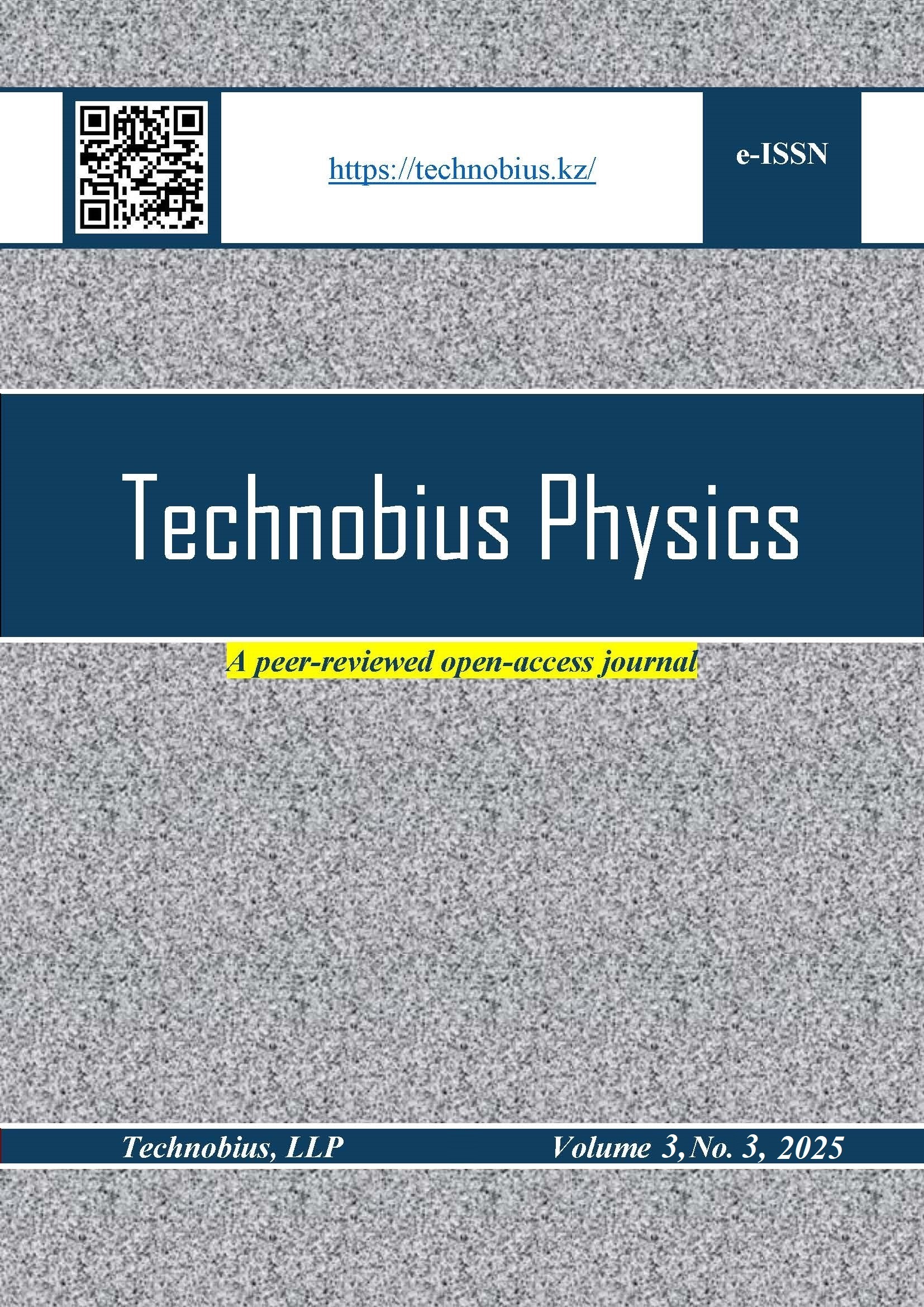Thickness- and gate-tunable ferromagnetism in low-dimensional Fe₃GeTe₂ nanoflakes
DOI:
https://doi.org/10.54355/tbusphys/3.3.2025.0039Keywords:
ferromagnetism, low-dimensional systems, Fe₃GeTe₂, anomalous Hall effect, perpendicular magnetic anisotropy, electrostatic gatingAbstract
This study investigates thickness- and gate-dependent magnetism in low-dimensional van der Waals ferromagnet Fe₃GeTe₂ nanoflakes. The objective was to quantify how critical magnetic parameters evolve when approaching the two-dimensional limit and under electrostatic carrier modulation. High-quality single crystals were grown by self-flux, and flakes with thicknesses between 7.5 and 26 nm were isolated, encapsulated with hexagonal boron nitride, and fabricated into Hall-bar devices. Magnetotransport, polar magneto-optical Kerr effect, and SQUID magnetometry were employed to probe Curie temperature, coercive field, anisotropy, anomalous Hall conductivity, and interlayer exchange. The results reveal a systematic reduction of Curie temperature from 206 K at 26 nm to 156 K at 7.5 nm, consistent with finite-size scaling. Coercive field increased nearly threefold across the same thickness range, accompanied by high anisotropy fields of 4–6 T, indicating enhanced surface-driven perpendicular magnetic anisotropy. Anomalous Hall conductivity rose with thickness and was dominated by intrinsic Berry curvature contributions. Magneto-optical measurements confirmed weakening of interlayer exchange coupling from 0.12 to 0.06 mJ·m⁻² as thickness decreased, marking the crossover toward quasi-two-dimensional behavior. Electrostatic gating of intermediate-thickness flakes shifted the Curie temperature by approximately 5 K per 10¹³ cm⁻² carrier density and reduced coercivity by about 10%, demonstrating effective electrical control of itinerant ferromagnetism. These findings establish a coherent picture of how thickness and carrier density tune magnetic order in Fe₃GeTe₂ nanoflakes. The results address the central research problem and highlight pathways for exploiting electrically tunable two-dimensional magnets in low-power spintronic applications.
Downloads
Metrics
References
P. J. Jensen and K. H. Bennemann, “Magnetism of interacting two-dimensional nanostructures,” in Frontiers in Magnetic Materials, Springer Berlin Heidelberg, 2005, pp. 459–501. doi: 10.1007/3-540-27284-4_16. DOI: https://doi.org/10.1007/3-540-27284-4_16
S. Dey, A. Bhattacharya, and S. Karmakar, “Enhanced long wavelength Mermin-Wagner-Hohenberg fluctuations in active crystals and glasses,” Nat. Commun. , vol. 16, no. 1, Dec. 2025, doi: 10.1038/s41467-025-61366-0. DOI: https://doi.org/10.1038/s41467-025-61366-0
R. Q. Wang, T. Cao, T. M. Lei, X. Zhang, and Y. W. Fang, “Control of magnetic transition, metal-semiconductor transition, and magnetic anisotropy in noncentrosymmetric monolayer Cr2Ge2Se3Te3,” Appl. Phys. Lett., vol. 127, no. 9, Sep. 2025, doi: 10.1063/5.0276143. DOI: https://doi.org/10.1063/5.0276143
J. W. Li, Z. Zhang, J. Y. You, B. Gu, and G. Su, “Two-dimensional Heisenberg model with material-dependent superexchange interactions,” Phys. Rev. B, vol. 107, no. 22, Jun. 2023, doi: 10.1103/PhysRevB.107.224411. DOI: https://doi.org/10.1103/PhysRevB.107.224411
S. T. Chyczewski, S. Park, and W. Zhu, “Magnetic Proximity Effects in Iron Germanium Telluride/Platinum Heterostructures,” ACS Appl. Mater. Interfaces, vol. 17, no. 20, pp. 30225–30232, May 2025, doi: 10.1021/acsami.5c01626. DOI: https://doi.org/10.1021/acsami.5c01626
E. J. Telford et al., “Coupling between magnetic order and charge transport in a two-dimensional magnetic semiconductor,” Nat. Mater., vol. 21, no. 7, pp. 754–760, Jul. 2022, doi: 10.1038/s41563-022-01245-x. DOI: https://doi.org/10.1038/s41563-022-01245-x
Y. Sun et al., “Localized Spin Textures Stabilized by Geometry-Induced Strain in 2D Magnet Fe3GeTe2,” Adv. Mater., Sep. 2025, doi: 10.1002/adma.202506279. DOI: https://doi.org/10.1002/adma.202506279
M. Wang et al., “Hard ferromagnetism in van der Waals Fe3GaTe2 nanoflake down to monolayer,” npj 2D Mater. Appl., vol. 8, no. 1, Dec. 2024, doi: 10.1038/s41699-024-00460-1. DOI: https://doi.org/10.1038/s41699-024-00460-1
T. You et al., “Nonvolatile ferroelectric manipulation of magnetoelectric coupling and band alignment in two-dimensional CrI3/In2Se3 multiferroic van der Waals heterostructures,” Phys. Lett. Sect. A Gen. At. Solid State Phys., vol. 548, Jul. 2025, doi: 10.1016/j.physleta.2025.130569. DOI: https://doi.org/10.1016/j.physleta.2025.130569
Y. Pan et al., “Direct evidence of boosted oxygen evolution over perovskite by enhanced lattice oxygen participation,” Nat. Commun., vol. 11, no. 1, Dec. 2020, doi: 10.1038/s41467-020-15873-x. DOI: https://doi.org/10.1038/s41467-020-15873-x
A. Dey, N. Chaudhary, I. Rajput, M. Kumar Dasoundhi, D. Kumar, and A. Lakhani, “Synthesis and Comparative Structural and Magnetotransport Study of Fe3GeTe2 Crystals Grown by Self-Flux and Chemical Vapor Transport Methods,” Phys. Status Solidi - Rapid Res. Lett., 2025, doi: 10.1002/pssr.202500211. DOI: https://doi.org/10.1002/pssr.202500211
Y. Ji et al., “Magnetism and microwave absorption properties of two-dimensional layered ferromagnetic metal Fe3GeTe2,” J. Mater. Sci., vol. 56, no. 29, pp. 16524–16532, Oct. 2021, doi: 10.1007/s10853-021-06339-6. DOI: https://doi.org/10.1007/s10853-021-06339-6
P. V. Kolluru et al., “AFM-based Dynamic Scanning Indentation (DSI) Method for Fast, High-resolution Spatial Mapping of Local Viscoelastic Properties in Soft Materials,” Macromolecules, vol. 51, no. 21, pp. 8964–8978, Nov. 2018, doi: 10.1021/acs.macromol.8b01426. DOI: https://doi.org/10.1021/acs.macromol.8b01426
Z. Feng et al., “Nonvolatile Electric Control of the Anomalous Hall Effect in an Ultrathin Magnetic Metal,” Adv. Electron. Mater., vol. 6, no. 2, Feb. 2020, doi: 10.1002/aelm.201901084. DOI: https://doi.org/10.1002/aelm.201901084
L. Mei et al., “Cd2+ Exchange for Na+ and K+ in the Interlayer of Montmorillonite: Experiment and Molecular Simulation,” J. Nanomater., vol. 2015, 2015, doi: 10.1155/2015/925268. DOI: https://doi.org/10.1155/2015/925268
M. V. Likholetova, E. V. Charnaya, E. V. Shevchenko, and Y. A. Kumzerov, “Superconductivity of the Bi–Sn Eutectic Alloy,” Phys. Solid State, vol. 63, no. 2, pp. 232–236, Feb. 2021, doi: 10.1134/S1063783421020153. DOI: https://doi.org/10.1134/S1063783421020153
Y. Tu et al., “Two-dimensional Cr-based ferromagnetic semiconductor: Theoretical simulations and design,” Front. Phys., vol. 10, Nov. 2022, doi: 10.3389/fphy.2022.1078202. DOI: https://doi.org/10.3389/fphy.2022.1078202
Z. gao et al., “Large and Tunable Magnetoresistance in Cr1−xTe/Al2O3/Cr1−xTe Vertical Spin Valve Device,” Adv. Electron. Mater., vol. 9, no. 1, Jan. 2023, doi: 10.1002/aelm.202200823. DOI: https://doi.org/10.1002/aelm.202200823
M. Alghamdi et al., “Layer-dependence study of two-dimensional ferromagnets: Fe3GeTe2 and Fe5Ge2Te2,” Appl. Phys. Lett., vol. 124, no. 19, May 2024, doi: 10.1063/5.0207209. DOI: https://doi.org/10.1063/5.0207209
F. Mende et al., “Large Anomalous Hall and Nernst Effects in High Curie-Temperature Iron-Based Heusler Compounds,” Adv. Sci., vol. 8, no. 17, Sep. 2021, doi: 10.1002/advs.202100782. DOI: https://doi.org/10.1002/advs.202100782
X. Li et al., “Interlayer ferromagnetic coupling in nonmagnetic elements doped CrI3 thin films,” Front. Phys., vol. 19, no. 6, Dec. 2024, doi: 10.1007/s11467-024-1435-2. DOI: https://doi.org/10.1007/s11467-024-1435-2
H. Zheng, R. Zhang, H. Han, C. Liu, and Y. Yan, “Electric field induced modulation to the magnetic anisotropy of Fe/silicene heterostructures: First-principles study,” J. Magn. Magn. Mater., vol. 484, pp. 172–178, Aug. 2019, doi: 10.1016/j.jmmm.2019.03.107. DOI: https://doi.org/10.1016/j.jmmm.2019.03.107
H. Ren and G. Xiang, “Strain Engineering of Intrinsic Ferromagnetism in 2D van der Waals Materials,” Nanomaterials, vol. 13, no. 16, Aug. 2023, doi: 10.3390/nano13162378. DOI: https://doi.org/10.3390/nano13162378
Downloads
Published
How to Cite
Issue
Section
Categories
License
Copyright (c) 2025 Zhang Wei

This work is licensed under a Creative Commons Attribution-NonCommercial 4.0 International License.








